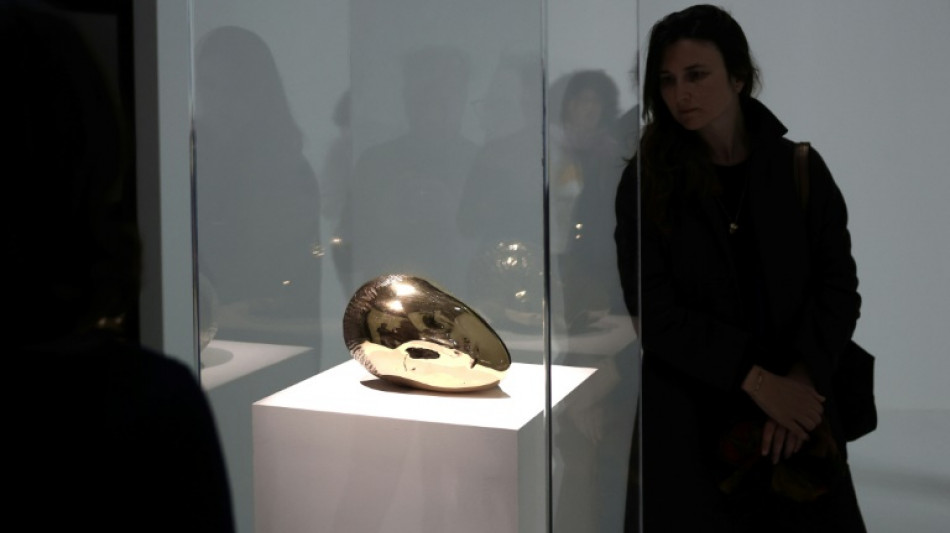
-
 DHL cargo plane crashes in Lithuania, killing one
DHL cargo plane crashes in Lithuania, killing one
-
Le Pen meets PM as French government wobbles

-
 From serious car crash to IPL record for 'remarkable' Pant
From serious car crash to IPL record for 'remarkable' Pant
-
Equity markets mostly on front foot, bitcoin rally stutters

-
 India crush Australia in first Test to silence critics
India crush Australia in first Test to silence critics
-
Philippine VP Duterte 'mastermind' of assassination plot: justice department

-
 Asian markets mostly on front foot, bitcoin rally stutters
Asian markets mostly on front foot, bitcoin rally stutters
-
India two wickets away from winning first Australia Test

-
 39 foreigners flee Myanmar scam centre: Thai police
39 foreigners flee Myanmar scam centre: Thai police
-
As baboons become bolder, Cape Town battles for solutions

-
 Uruguay's Orsi: from the classroom to the presidency
Uruguay's Orsi: from the classroom to the presidency
-
UN chief slams landmine threat days after US decision to supply Ukraine

-
 Sporting hope for life after Amorim in Arsenal Champions League clash
Sporting hope for life after Amorim in Arsenal Champions League clash
-
Head defiant as India sense victory in first Australia Test

-
 Scholz's party to name him as top candidate for snap polls
Scholz's party to name him as top candidate for snap polls
-
Donkeys offer Gazans lifeline amid war shortages

-
 Court moves to sentencing in French mass rape trial
Court moves to sentencing in French mass rape trial
-
'Existential challenge': plastic pollution treaty talks begin

-
 Cavs get 17th win as Celtics edge T-Wolves and Heat burn in OT
Cavs get 17th win as Celtics edge T-Wolves and Heat burn in OT
-
Asian markets begin week on front foot, bitcoin rally stutters

-
 IOC chief hopeful Sebastian Coe: 'We run risk of losing women's sport'
IOC chief hopeful Sebastian Coe: 'We run risk of losing women's sport'
-
K-pop fans take aim at CD, merchandise waste

-
 Notre Dame inspired Americans' love and help after fire
Notre Dame inspired Americans' love and help after fire
-
Court hearing as parent-killing Menendez brothers bid for freedom

-
 Closing arguments coming in US-Google antitrust trial on ad tech
Closing arguments coming in US-Google antitrust trial on ad tech
-
Galaxy hit Minnesota for six, Orlando end Atlanta run

-
 Left-wing candidate Orsi wins Uruguay presidential election
Left-wing candidate Orsi wins Uruguay presidential election
-
High stakes as Bayern host PSG amid European wobbles

-
 Australia's most decorated Olympian McKeon retires from swimming
Australia's most decorated Olympian McKeon retires from swimming
-
Far-right candidate surprises in Romania elections, setting up run-off with PM

-
 Left-wing candidate Orsi projected to win Uruguay election
Left-wing candidate Orsi projected to win Uruguay election
-
UAE arrests three after Israeli rabbi killed

-
 Five days after Bruins firing, Montgomery named NHL Blues coach
Five days after Bruins firing, Montgomery named NHL Blues coach
-
Orlando beat Atlanta in MLS playoffs to set up Red Bulls clash

-
 American McNealy takes first PGA title with closing birdie
American McNealy takes first PGA title with closing birdie
-
Sampaoli beaten on Rennes debut as angry fans disrupt Nantes loss

-
 Chiefs edge Panthers, Lions rip Colts as Dallas stuns Washington
Chiefs edge Panthers, Lions rip Colts as Dallas stuns Washington
-
Uruguayans vote in tight race for president

-
 Thailand's Jeeno wins LPGA Tour Championship
Thailand's Jeeno wins LPGA Tour Championship
-
'Crucial week': make-or-break plastic pollution treaty talks begin

-
 Israel, Hezbollah in heavy exchanges of fire despite EU ceasefire call
Israel, Hezbollah in heavy exchanges of fire despite EU ceasefire call
-
Amorim predicts Man Utd pain as he faces up to huge task

-
 Basel backs splashing the cash to host Eurovision
Basel backs splashing the cash to host Eurovision
-
Petrol industry embraces plastics while navigating energy shift

-
 Italy Davis Cup winner Sinner 'heartbroken' over doping accusations
Italy Davis Cup winner Sinner 'heartbroken' over doping accusations
-
Romania PM fends off far-right challenge in presidential first round

-
 Japan coach Jones abused by 'some clown' on Twickenham return
Japan coach Jones abused by 'some clown' on Twickenham return
-
Springbok Du Toit named World Player of the Year for second time

-
 Iran says will hold nuclear talks with France, Germany, UK on Friday
Iran says will hold nuclear talks with France, Germany, UK on Friday
-
Mbappe on target as Real Madrid cruise to Leganes win


Rare exhibition for revolutionary sculptor Brancusi in Paris
A rare retrospective of artist Constantin Brancusi, who revolutionised sculpture in the early 20th century but whose works can be extremely tricky to transport, opens in Paris on Wednesday.
Born in Romania in 1876, Brancusi arrived in Paris at age 28 and soon after joined the workshop of another historic sculptor, Auguste Rodin.
"Nothing grows in the shadow of large trees," Brancusi reportedly said after spending just three months with the creator of "The Kiss" and "The Thinker".
Working directly with wood and marble, and without using moulds, Brancusi launched a radical new approach to sculpture that sought to purify human forms into abstract shapes.
"It is such a pity to have to spoil a beautiful material by hollowing out little holes for eyes, hair, ears," he said.
More than 120 sculptures and hundreds of sketches, paintings and documents are exhibited at the Pompidou Centre until July 1 -- the first retrospective on this scale in almost 30 years.
That is because many of his key works -- particularly the plaster towers balanced precariously on a small base -- cannot be transported without enormous insurance costs.
The last retrospective in 1995 was also at the Pompidou, which inherited Brancusi's nearby workshop and entire personal collection.
Visitors can explore how his work evolved through different versions of his best-known work, "The Sleeping Muse", or a celebrated bust of a child, or his birds and seals.
Brancusi "crosses all the movements of the 20th century," said exhibition curator Ariane Coulondre.
"He can be considered one of the fathers of abstract art, without being abstract at all. He never wanted to be part of any movement," she added.
Tirelessly reworking his sculptures in search of a pure style, Brancusi gave hardly any interviews and refused to have an agent, selling directly to buyers who had to visit his workshop.
Then in 1945, he abruptly stopped work, considering he had nothing more to add.
He made no more sculptures in his final 12 years, instead spending the time rearranging his workshop and selling remaining pieces -- but having already transformed the world of sculpture.
B.Shevchenko--BTB




